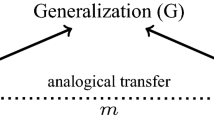Abstract
This paper introduces a conceptual model for representing queries, statements, and knowledge in an analogy-enabled information system. Analogies are considered to be one of the core concepts of human cognition and communication, and are very efficient at conveying complex information in a natural fashion. Integrating analogies into modern information systems paves the way for future truly human-centered paradigms for interacting with data and information, and opens up a number of interesting scientific challenges, especially due to the ambiguous and often consensual nature of analogy statements. Our proposed conceptual analogy model therefore provides a unified model for representing analogies of varying complexity and type, while an additional layer of interpretation models adapts and adjusts the operational semantics for different data sources and approaches, avoiding the shortcomings of any single approach. Here, especially the Social Web promises to be a premier source of analogical knowledge due to its rich variety and subjective content, and therefore we outline first steps for harnessing this valuable information for future human-centered information systems.
Access this chapter
Tax calculation will be finalised at checkout
Purchases are for personal use only
Preview
Unable to display preview. Download preview PDF.
Similar content being viewed by others
References
Gentner, D., Markman, A.B.: Structure mapping in analogy and similarity. American Psychologist 52, 45–56 (1997)
Hofstadter, D.R.: Analogy as the Core of Cognition. The Analogical Mind, 499–538 (2001)
Gentner, D.: Why We’re So Smart. Language in Mind: Advances in the Study of Language and Thought, pp. 195–235. MIT Press (2003)
Ferrucci, D., Brown, E., Chu-Carroll, J., Fan, J., Gondek, D., Kalyanpur, A.A., Lally, A., Murdock, J.W., Nyberg, E., Prager, J., Schlaefer, N., Welty, C.: Building Watson: An Overview of the DeepQA Project. AI Magazine 31, 59–79 (2010)
Gentner, D.: Structure-mapping: A theoretical framework for analogy. Cognitive Science 7, 155–170 (1983)
Chalmers, D.J., French, R.M., Hofstadter, D.R.: High-level perception, representation, and analogy: A critique of artificial intelligence methodology. Journal of Experimental & Theoretical Artificial Intelligence 4, 185–211 (1992)
Shelley, C.: Multiple Analogie in Science and Philosophy. John Benjamins Pub. (2003)
Juthe, A.: Argument by Analogy. Argumentation 19, 1–27 (2005)
Forbus, K.D., Mostek, T., Ferguson, R.: Analogy Ontology for Integrating Analogical Processing and First-principles Reasoning. In: Nat. Conf. on Artificial Intelligence (AAAI), Edmonton, Alberta, Canada (2002)
Harris, Z.: Distributional Structure. Word 10, 146–162 (1954)
Ishizuka, M.: Exploiting macro and micro relations toward web intelligence. In: Zhang, B.-T., Orgun, M.A. (eds.) PRICAI 2010. LNCS, vol. 6230, pp. 4–7. Springer, Heidelberg (2010)
Turney, P.: A Uniform Approach to Analogies, Synonyms, Antonyms, and Associations. In: 22th Int. Conf. on Computational Linguistics (COLING), Beijing, China (2008)
Bollegala, D.T., Matsuo, Y., Ishizuka, M.: Measuring the similarity between implicit semantic relations from the web. In: 18th Int. Conf. on World Wide Web (WWW), Madrid, Spain (2009)
Turney, P.D., Littman, M.L., Bigham, J., Shnayder, V.: Combining Independent Modules to Solve Multiple-choice Synonym and Analogy Problems. In: Int. Conf. on Recent Advances in Natural Language Processing, RANLP (2003)
Gentner, D., Gunn, V.: Structural alignment facilitates the noticing of differences. Memory & Cognition 29, 565–577 (2001)
Hummel, J.E., Holyoak, K.J.: Relational Reasoning in a Neurally Plausible Cognitive Architecture. An Overview of the LISA Project. Current Directions in Psychological Science 14, 153–157 (2005)
Breitman, K.K., Barbosa, S.D.J., Casanova, M.A., Furtado, A.L.: Conceptual modeling by analogy and metaphor. In: ACM Conf. in Information and Knowledge Management (CIKM), Lisabon, Portugal (2007)
Lofi, C.: Just ask a human? – Controlling Quality in Relational Similarity and Analogy Processing using the Crowd. In: CDIM Workshop at Database Systems for Business Technology and Web (BTW), Magdeburg, Germany (2013)
Selke, J., Homoceanu, S., Balke, W.-T.: Conceptual Views for Entity-Centric Search: Turning Data into Meaningful Concepts. Computer Science: Research and Development 27, 65–79 (2012)
Lee, A., Wang, Z., Wang, H., Hwang, S.: Attribute Extraction and Scoring: A Probabilistic Approach. In: Int. Conf. on Data Engineering (ICDE), Brisbane, Australia (2013)
Davidov, D.: Unsupervised Discovery of Generic Relationships Using Pattern Clusters and its Evaluation by Automatically Generated SAT Analogy Questions. Ass. for Computational Linguistics: Human Language Technologies (ACL:HLT), Columbus, Ohio, USA (2008)
Selke, J., Lofi, C., Balke, W.-T.: Pushing the Boundaries of Crowd-Enabled Databases with Query-Driven Schema Expansion. In: 38th Int. Conf. on Very Large Data Bases (VLDB), vol. 5(2), pp. 538–549, PVLDB Istanbul (2012)
Wu, W., Li, H., Wang, H., Zhu, K.: Probase: A Probabilistic Taxonomy for Text Understanding. In: SIGMOD Int. Conf. on Management of Data, Scottsdale, USA (2012)
Nakashole, N., Weikum, G., Suchanek, F.: PATTY: A Taxonomy of Relational Patterns with Semantic Types. In: Int. Conf. on Empirical Methods in Natural Language Processing (EMNLP 2012), Jeju Island, Korea (2012)
Pei, J., Han, J., Mortazavi-asl, B., Pinto, H., Chen, Q., Dayal, U., Hsu, M.: PrefixSpan: Mining Sequential Patterns Efficiently by Prefix-Projected Pattern Growth. IEEE Computer Society (2001)
Author information
Authors and Affiliations
Editor information
Editors and Affiliations
Rights and permissions
Copyright information
© 2013 Springer International Publishing Switzerland
About this paper
Cite this paper
Lofi, C., Nieke, C. (2013). Modeling Analogies for Human-Centered Information Systems. In: Jatowt, A., et al. Social Informatics. SocInfo 2013. Lecture Notes in Computer Science, vol 8238. Springer, Cham. https://doi.org/10.1007/978-3-319-03260-3_1
Download citation
DOI: https://doi.org/10.1007/978-3-319-03260-3_1
Publisher Name: Springer, Cham
Print ISBN: 978-3-319-03259-7
Online ISBN: 978-3-319-03260-3
eBook Packages: Computer ScienceComputer Science (R0)




